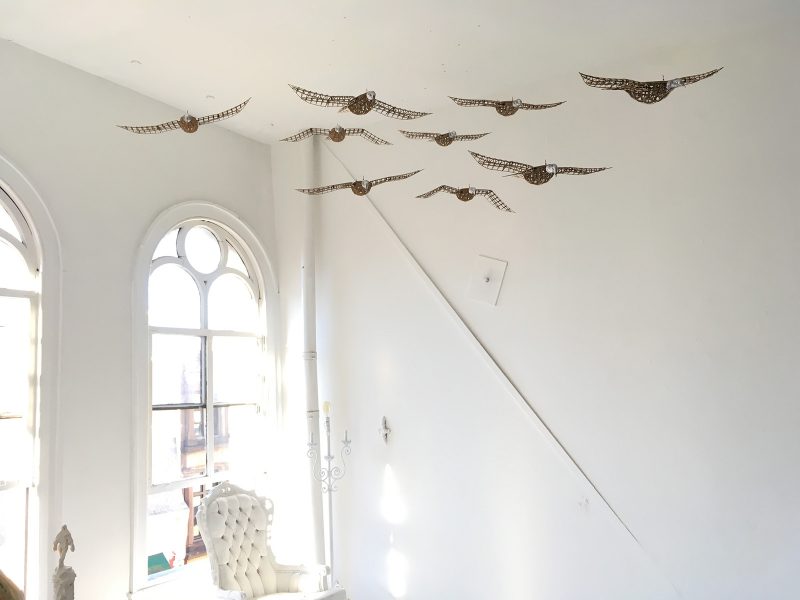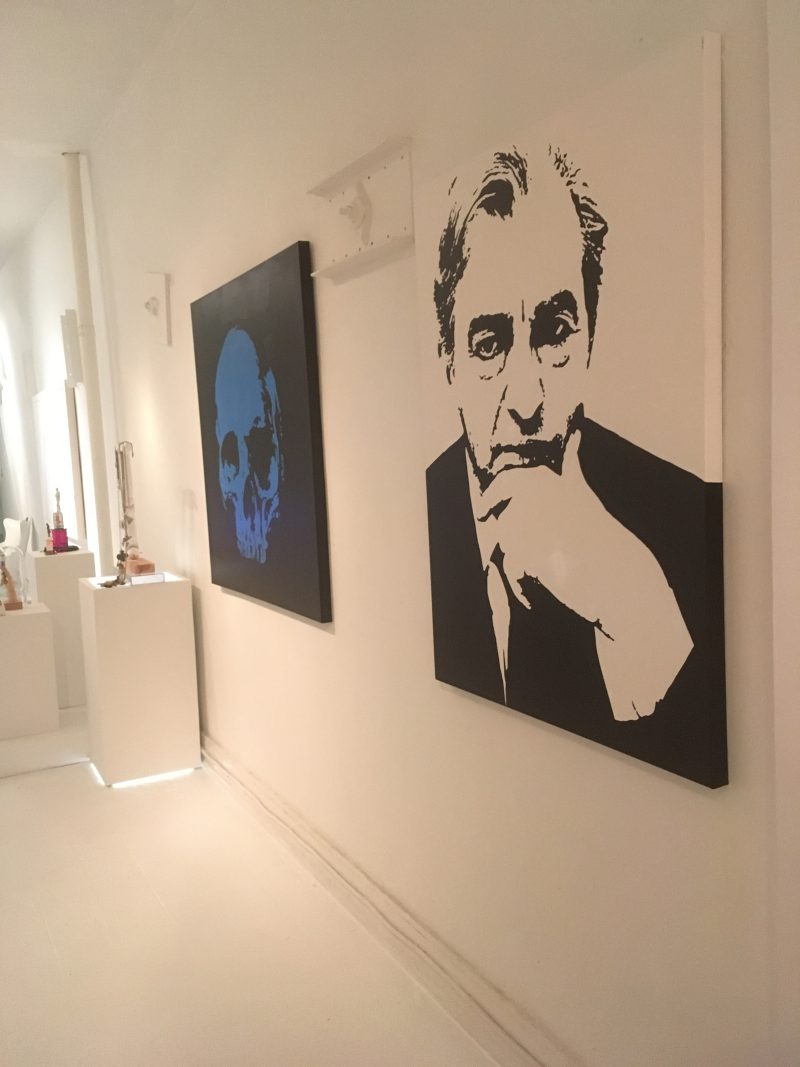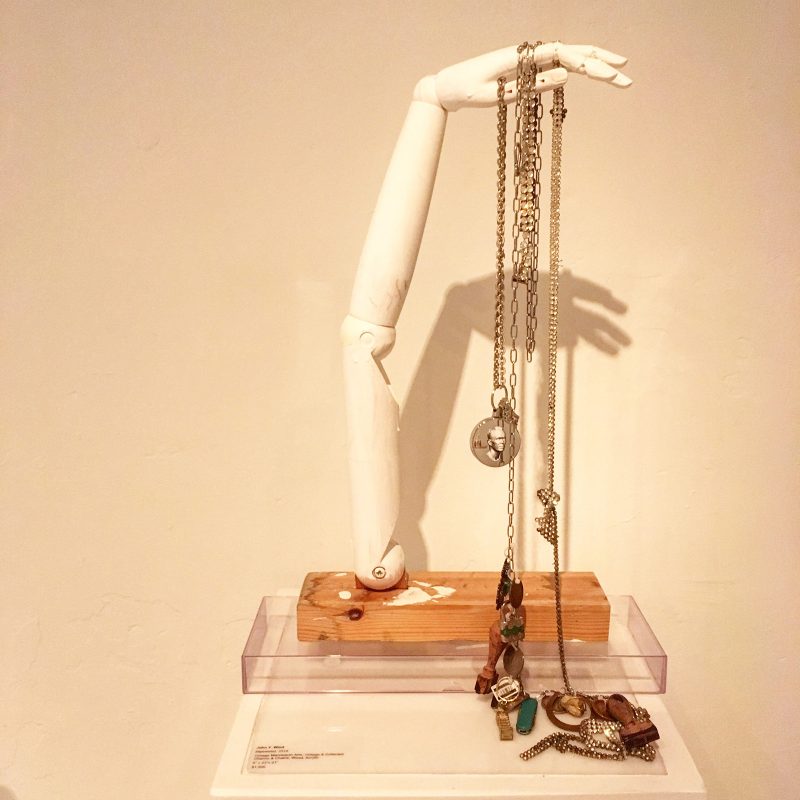To say the stairs are steep at the James Oliver Gallery is to say Mt. Everest is high. I have a mind to petition for a rest stop two flights up. The payoff, though, is a few calories lost and a big white cube. A strip of room as long as a bowling lane ends with a spacious bar and a plum view of downtown. Paintings, drawings, sculptures, and assemblage pieces fill most of the wall space. It’s the tenth anniversary show—JOG10, and there’s an installation of wooden birds—a flock in, um, flight. Wings spread, they hang like mobiles. For the most part, these pieces are neither decorative nor intractable. The gallery itself is a welcome contrast to the NBA-level jockeying for relevance that exists in galleries like Pace or the Gagosian. The James Oliver Gallery is like Philly, the way the city is to New York–more laidback and a little less self-important.

I’m talking with James Oliver, the owner of course, and he’s the easiest guy to talk to. I’ve talked to him many times before. This is my third time writing about this place, about the stairs, the interior, and Oliver’s breezy demeanor. There was a time I was here, and there was an impromptu poetry reading by a local band. I was here with a Ugandan playwright and filmmaker from Kenya, and we had just seen “The Convert” at the Wilma Theatre. The gallery, needless to say, was lit, well lit, and as always, plenty of drinks and plenty of music. That’s his thing, though. Music. James Oliver digs sounds. He’s the man behind the Austin Acoustic Music Festival. He was the face of Austin at SXSW. He’s from Texas. He’s from Puerto Rico. I mean, his parents left the island for Austin way back when. Oliver makes sure that I know this gallery wasn’t a leap of faith but a natural next step. In Austin, he headed the arts commission in his city, so this is nothing new.
Old and new
The anniversary show boasts old and new, and soon to come–a nod to past shows, recent shows, and shows yet to be. There’s one in the works for self-taught artist Kevin Bourgeois. His collage “Prolonging the Magic” makes me think of Bearden’s “The Block” or to be honest, a multitude of works by Bearden.
Michael Grimaldi’s two-dimensional pieces evoke a dreamed occurrence, you know, charcoal’s tendency towards surreal illusionism. There’s figuration by its implied absence, compression, disruption, displacement, the work necessary to get up from “Bed #4,” the residue of space occupied. There’s an anti-presence, and I surmise that some man or woman has been here. Unreason tells me to scream. But I look right to see a woman partly clothed in a three-quarter view profile turned left. Her right hand lie atop a reclining nude man, inches away from his flaccid dong. The woman’s shadowy edge, her back, bisects the picture plane and contrasts an empty pillow. This is “Bed #5.” The man is asleep, but, no, I can’t tell, his head is missing, hidden behind her. Post-coitus or otherwise, he’s done. I’m made to remember Manet’s “Olympia” and the old French tizzy around that. But that was then, and I think now I’m looking for more out of a drawing, like pieces by Aurelien Coupot or Charles White. I guess besides good-old intention, I need a thing differently drawn, curiously rendered.

Looming shadows
Steven Mogck’s “Skull” is a sharp contrast. Its immediacy is inescapable. The piece looms over everything in viewing distance. It’s easily the most prominent visual phenomenon in the exhibit besides the gallery lights. A 48” x 48” canvas with a black background buoys a large graphically sound blue skull. What happens is both a physiological and visual jolt. I’m thinking this is the kind of piece that would work well in a bachelor pad, a nice loft—celebrities buy Mogck—but turning my eyes away, what I’m left with is its optical complement, an orangey remainder, a color now in possession of a potent political agency.
So I’m not surprised when I discover Upin’s “Orange Shadow (Trump’s Nightmare)” opposite “Skull.” It’s one half of a diptych of sorts, hanging to the right of its twin “Small World.” I mean, they’re a little different from each other, but both are prints with similar subjects—a portly woman sitting on something we can’t see, and both are covered in Gila monster-like splotches of blue and red respectively. In “Small World” a frontal portrait, a silkscreen of a seated brunette in a blue dress hovers in the center of the composition. We get ground by inference, an intuitively imagined reality only hinted at by an illusionistic shadow, her foreshortened two-dimensional self not lit. She’s fixated on what’s below and hierarchically low, a stylized, italicized snippet of a well-used axiom—“it’s a small world.” In “Orange Shadow” as with “Small World” the woman is staring down at a print, breaching the implied, illusionistic real space to see actual two-dimensional reality (which is in fact three-dimensional at its core, microscopically-speaking), a few letters, and in the case with “Orange Shadow,” a full body profile of a reclining man, a silhouette of him and his partly erect endowment. This is the hook I suppose, his orangey self in direct line of sight of her.

The shape of things
Matthew Davis, though, spells out what’s suggested by these works—“Art is My Weapon.” That’s the title of his sculptural assemblage piece that brings to mind Schwitter’s work in the early 20th century. But this piece isn’t charging after the same hard-art, endgame aspirations of the modernists. Here’s the thing: I’m seeing what? A satellite image of a town or something, architectural plans, plywood shaped by a jigsaw, the whole thing in the shape of an uzi or some other insta-death contraption. I know, just knock me over the head with a message why don’t you, but what I’m thankful for is the piece’s attempt to usurp visual lingo’s command, to take back the shape of things, to reclaim the unconscious geometric real estate occupied by the worst of us, or the worst things we can muster—worse things for better or worse living. The shape of a gun is now the shape of cultural currency. It’s the same thing David Hammons does with a spade. Let’s start a conversation not a skirmish. You know what I mean?
I’m listening to the song “Build Me Up Buttercup,” navigating through JOG10. Oliver had told me he was an honorary member of Flowerhead, Texas’s answer to Nirvana or R.E.M., which makes me think about how shows differ for different arts. I suppose writers get the worst reception in this regard, like nothing immediate unless accompanied by a backing beat and/or a damned good voice. A gallery opening is nothing like a concert, which I appreciate, but I wonder about the half-empty galleries sometimes. I think it’s the shit, but I feel like sometimes I’m witnessing currency in a waiting room. I can’t afford these things, the art that hits the spot, a companion to an artful way of experience. I know it’s something else, and I can’t knock the hustle, and so I guess with the arts you make meaning as you go along like everyone else. The artist, though, knows this more than others, how meaning is made. It’s his trade, and maybe that’s exactly what he takes with him to these unpopular places, so necessary to greet the alien.
Oliver’s telling me about a lot of things, his bio, his journey to Philly, and I don’t admit to him I’m distracted by his hoodie, his entire get-up. It’s all splattered with paint—a wearable Pollock. I’m also lured away at times by Cheryl Harper’s sculpture nearby: a plate of chocolates, oversized M&M’s, a guilty pleasure, but in this portion, a thing that rots like most candy, eye candy, a few bars, a fix.
But lastly, I end up at Oliver’s own work, a work-in-progress, a small canvas on a small easel, a joke of a painting, a car much like a grade school doodle, a photo of a red car, or is it all an installation? I don’t ask, but it’s central to the show, a work in progress like the gallery, like an interpretation of a work. James Oliver did it, and this is the evidence. Ten years ago, Philly added another gallery to its tally, and ten years later it’s still here. That’s what’s up.










